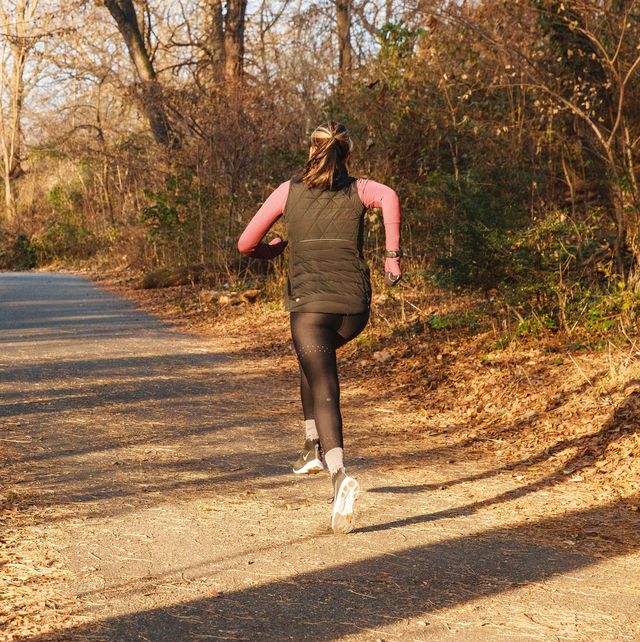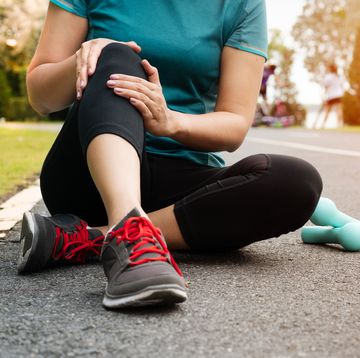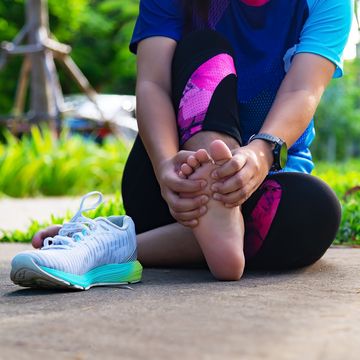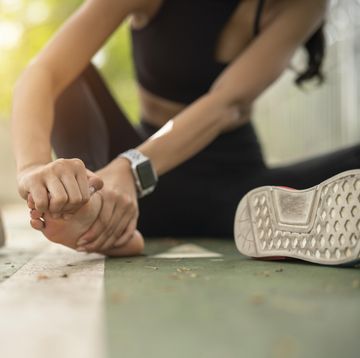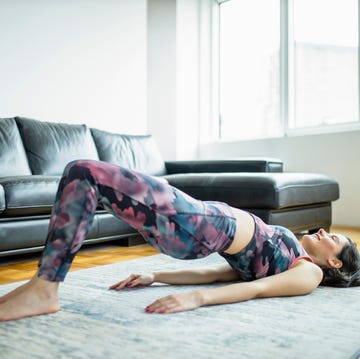When I first started running about seven years ago, my shoulders would randomly throb mid-workout. The shoulder pain while running was definitely annoying – and, on occasion, pretty excruciating – but it dissipated the more I ran, so I didn’t think much of it. However, over the years, that sore sensation has sporadically returned. A recent run left my shoulders burning more than my quads, making me wonder what on earth was going on.
As it happens, I’m not the only runner who is plagued and confused by sore shoulders. Elizabeth Lamontagne, assistant director and physical therapist at Recovery Physical Therapy in New York City, in the US, says that about half of the runners she sees experience shoulder pain.
Here, we investigate the causes of mid-run shoulder pain and share some expert tips on how to prevent and alleviate this irksome issue.
What everyone's reading
Why do my shoulders ache while I run?
According to Ramon Julian Pesigan, an assistant professor at Mount Sinai Health System, running is a ‘very dynamic form of exercise’ that relies on many different muscle groups, including the shoulders, neck and upper back. While these upper body muscles are not the main drivers in running, they do play an important role in helping us to run with good posture, which maximises the efficiency of your stride and reduces your risk of injury. To run with good posture, make sure that your shoulder blades are back and down, your chest is up, your eyes are forward and your neck is in line with your spine.
Shoulder pain can crop up in different regions of the shoulder muscle group during a run. These regions include the upper trapezius (a muscle that attaches to the neck, shoulders, spine and base of the skull), the deltoids (sides of the shoulders) and the rotator cuff (muscles and tendons surrounding the shoulder joint).
9 common causes of shoulder pain
1. You recently started running or increased your mileage
Any time you start a new activity – or dial up the intensity of a current activity – your body is going to feel the effects of that change as it works to adapt to the increased demands. As kinesiologist and exercise physiologist Dean Somerset notes, if you’ve just started running after a long hiatus, or have suddenly bumped up your mileage, all the muscles involved in running – including your shoulders – are going to take on extra stress and pain at first.
How to treat it
DeAnne Davis Brooks, a running coach, exercise physiologist and associate professor in the department of kinesiology at the University of North Carolina Greensboro, suggests icing sore areas for 20 minutes. Then, wait one to two hours and ice the area again if needed.
Try to stick with your regular exercise routine, but dial back the intensity if your shoulder soreness is too acute for that. The aches should subside in a week or less. If soreness doesn’t get better after that time, Brooks suggests visiting a physiotherapist to make sure that you’re not dealing with an injury.
How to prevent it
Ramp up your training gradually to avoid excessively stressing your shoulders (and the rest of your body).
2. You’re holding too much tension in your upper body
When runners get tired or try to push the pace, they may inadvertently tense their neck muscles and hike up their shoulders, explains Rajwinder Singh Deu, assistant professor of orthopaedic surgery at the Johns Hopkins School of Medicine. As Somerset adds, other runners may consistently hold extra tension in their upper body as they stride.
In both scenarios, this excess tension can fatigue and tighten the shoulder muscles and lead to shoulder pain. If your shoulder pain is accompanied by jaw and neck pain, this could be a sign that you are holding too much tension in your upper body as you run, says Somerset. Another indication is if you feel like you can’t move your shoulders while running.
How to treat it
Ice sore areas – start with 20 minutes, wait one to two hours, then ice again if needed – and, if the pain is severe, reduce the intensity of your running until it subsides. Otherwise, keep training as usual and follow the tips below to prevent the issue from returning.
How to prevent it
As you stride, stay mindful of where you hold tension. If you feel pain creeping into your shoulders, Brooks suggests focusing on the muscle (or muscles) that hurts, breathing through the discomfort and trying to relax the area.
3. You have poor posture
All of the experts agreed that poor posture – in other words, rounding your shoulders, hiking your shoulders up toward your ears and leaning your head forward – is a big cause of shoulder pain while running. As physiotherapist Brando Lakes explains, this improper positioning can cause your upper trapezius and levator scapulae (a neck muscle that connects at the very top of the spine) to take on too much work – and when these muscles become overused, they’ll start to ache. Sometimes, poor posture can lead to non-specific pain that radiates, adds Lamontagne.
How to treat it
Again, ice sore areas as needed and dial back your training as appropriate. To truly treat the issue, however, you’ll need to identify and correct your poor posture. You can do the former by filming yourself or, if you’re passing a shop front, taking a quick glance at your reflection, says Lamontagne. Form errors can be tricky to spot, though, so you may also want to get a gait analysis or an evaluation by a running coach or physiotherapist to learn exactly what you’re doing wrong – and how to fix it.
How to prevent it
Stay mindful of your posture as you run. Remember: shoulder blades back and down, chest up, eyes forward, neck in line with your spine. If you feel yourself slipping into poor posture as you run, drop your hands and shake them out, or do a quick shoulder roll forward and backward, suggests Brooks.
This mini stretch break can help you to refocus your attention on maintaining good form while quickly reprieving aching muscles. It’s also important to practice good posture in your everyday life, especially since many of us spend our days hunched over desks at work or at home. As Brooks says, taking the time to set up an ergonomic workspace can make a big difference.
4. Your arm swing is off
Aggressively swinging your arms across your body as you run could over-engage your pectoralis minor (a small chest muscle), says Lakes, as well as your deltoids and rotator cuff, says Somerset. The overuse of these muscles, in turn, could cause shoulder pain.
How to treat it
Bring one arm behind your back, grab it with your other arm, pull down and tilt your head away from that shoulder to give your deltoids and traps a deep stretch, says Somerset. You can also soothe aching pec minors with a simple doorway stretch from Lakes, which is detailed below. Then, work on correcting your arm swing.
How to prevent it
Think about running with your elbows at right angles, your arms open and relaxed and your hands loose, says Brooks. As you stride, move your shoulders forward and backward – not across your body.
5. Your upper body is weak
If your upper body isn’t strong enough to maintain proper running form over the course of your run, you’ll likely slip back into ache-inducing habits, like hunching forward or swinging your arms across your chest, says Brooks.
How to treat it
Your mid-back muscles play an important role in maintaining good running posture. If you struggle to do an inverted row, you probably need to strengthen that area, says Lamontagne. But good running form is about more than just your back, so if you suspect that other upper body muscles are lacking strength, see a personal trainer to pinpoint areas of weakness and develop a plan for strengthening them.
How to prevent it
Incorporate upper body strength training alongside running workouts to build and maintain strength in your upper half. Pesigan suggests doing compound exercises (in other words, moves that work multiple muscles at once) as opposed to isolation exercises (which work just one muscle group at a time), as the former more closely mimics the dynamic movements of running.
Lakes also says that it’s a good idea to build strength in muscles that help you to maintain proper form while running, like the triceps, biceps and deltoids, as well as the big muscles of the back. According to Deu, you’ll want to strengthen the rotator cuff and muscles surrounding the neck, too.
6. You need new running shoes
If you’re running in worn-out shoes, the lack of support will change your gait and stride. Those tweaks in form will travel upward, potentially causing pain (and sometimes even injury) in your upper half. So, check your running shoes. Are they noticeably worn on the bottom? Is the foam uneven on one side? If yes, that could explain your recent shoulder pain.
How to treat it
To alleviate soreness, Pesgian suggests doing easy range of motion exercises, like the downward dog, the child’s pose, shoulder circles and arm raises to the front and sides. You can also ice aching shoulders, for about 15 to 20 minutes at a time, and swap out your worn running shoes for a fresh pair.
How to prevent it
Buy new running shoes well before your current ones fall apart. Decent running shoes will typically serve you well for 300 to 500 miles.
7. You’re stressed
Some people hold stress in their neck and shoulders – and even though running can be a great reliever of stress, Brooks says that this tension may not necessarily subside when you lace up.
How to treat it
Take a minute to check in with yourself. Have you been feeling more anxious than usual recently? Additional angst could be the cause of your shoulder pain. If that’s the case, it will persist outside of your workout.
How to prevent it
Do what you can to prioritise your mental health. As mentioned, running can be a powerful tool for managing stress, but make sure that you’re running with proper form so that you don’t accidentally exacerbate your shoulder tightness while you stride, says Brooks.
8. You’re an aggressive heel striker
If you run with a really harsh heel strike – which means that your heel hits the pavement first, and forcibly, with every stride – the resulting ground shock will go through your body and travel upward to your shoulders, says Somerset. The muscles that hold your shoulders in place have to contract with every heel strike to bear against the ground shock – and that repetitive contraction can lead to fatigue and soreness.
Look at the bottom of your running shoes. If you see a lot of wear around the heel and not much wear anywhere else, you’re likely a heel striker. As Somerset says, this habit could explain your shoulder pain.
How to treat it
Try shifting your run stride so that your midfoot or forefoot is the first point of contact with the ground, advises Somerset.
How to prevent it
If you’re a known heel striker, ask a specialist at your local running shop for help finding shoes that reduce the impact of a heel strike.
9. Your shoulders are too relaxed
As mentioned, you don’t want to hold too much tension in your shoulders as you stride. Then again, you don’t want to be too loose, warns Somerset, as that floppiness could cause your shoulders to bounce around with every foot strike and become both stretched and loaded under tension.
How to treat it
Somerset suggests simply resting for a day or two – any aches caused by overly-relaxed shoulders should subside in that time. Then, follow the tip below to solve the underlying issue.
How to prevent it
Lightly brace your core as you run, suggests Somerset. This can help you to draw your shoulders in tight enough against your ribs.
When to see a doctor about shoulder pain
There’s a difference between shoulder pain caused by sore muscles and shoulder pain caused by injury, so it’s important to understand the distinction, says Brooks.
If your shoulder pain from running is so severe that you can’t run or perform day-to-day activities, you should see a medical professional. You should also call your GP or personal trainer, if you have one, if the pain continues despite your best efforts to remedy the underlying cause. If your pain can be tied to a specific incident, or seems to get worse over time, that’s yet another reason to get checked out by a professional, adds Brooks.
Stretches to alleviate tight shoulders
If your shoulders hurt from running, it’s important to identify and address the underlying cause so that you can find a long-term solution. It’s also, as mentioned, a good idea to incorporate regular upper body strength training into your routine, as that will increase your capacity to endure a repetitive activity like running, says Pesigan.
However, you can still do shoulder stretches to temporarily alleviate tightness caused by running. Here are six expert-recommended stretches to do before a run (once you’ve warmed up a little, so that you’re not stretching cold muscles), or after. Don’t forget that stretching should feel gentle – if you feel any pain or discomfort as you do these moves, back off.
Pec minor doorway stretch
How to do it
Stand in front of a doorway and place one elbow and forearm on the doorframe. Position your elbow slightly below shoulder height and draw your shoulder blades together. Slowly take several steps forward through the doorway, keeping your elbow and forearm fixed on the doorframe. You will feel a gentle stretch in the front of your chest. Then, back up slightly and rotate your body away from the elbow and forearm that are fixed on the doorframe. Stop rotating when you feel a gentle stretch in the area where your chest connects to your shoulder. Hold for 30 seconds, then switch sides and repeat.
Trapezius stretch
How to do it
Clasp your hands together behind your back and pull your shoulder blades together and down. Drop your chin to increase the stretch in your traps, then gently rock your head from side to side to stretch the muscle from different angles. Continue for 15 to 30 seconds. Rest, then repeat.
Side shoulder stretch
How to do it
Cross your left arm in front of your body and place your right hand on top of your upper left arm. Press against the upper left arm to increase the stretch on the side of your left shoulder. Hold for 15 to 30 seconds. As you stretch, make sure that your shoulders stay down – don’t let them hunch up toward your ears. This is one rep. Rest, then repeat for another rep. Switch arms and do another two reps, taking rests in between.
Shoulder circles
How to do it
Stand up tall and reach your right hand in front as if you’re able to shake hands. Over the course of five seconds, continue raising your arm overhead, rub your bicep against your ear and reach your arm behind you as far as you can without letting your arm drift horizontally. Then, reverse the movement over the course of five seconds. As you move your arm, you should feel a stretch in the muscles surrounding your shoulder blade. This is one rep. Do five reps in total, then switch arms and do another five reps.
Lat stretch
How to do it
Lie on your back with your knees bent and your feet flat on the ground. Place a foam roller lengthways along your spine. Raise your arms straight up, with your palms facing each other. Then, reach your arms straight back over your head, keeping your elbows straight. You should feel a gentle stretch in your torso and the sides of your armpits. Hold for 60 seconds.
Pec stretch
How to do it
Lie on your back with your knees bent and your feet flat on the ground. Place a foam roller lengthways along your spine. Raise your arms straight up and open them horizontally into a ‘T’ position, with your palms facing up and your arms hovering just above ground level. You should feel a gentle stretch in your chest, biceps, the front of your shoulders and possibly in your forearms and wrists. Hold for 60 seconds.
According to Brooks, you can also treat achy shoulders with ice (as mentioned), as well as with self-massage or a sports massage. Just be careful with sports massages if you’re new to them, though – they can be quite forceful and cause additional soreness.

Jenny is a Boulder, Colorado-based health and fitness journalist. She’s been freelancing for Runner’s World since 2015 and especially loves to write human interest profiles, in-depth service pieces and stories that explore the intersection of exercise and mental health. Her work has also been published by SELF, Men’s Journal, and Condé Nast Traveler, among other outlets. When she’s not running or writing, Jenny enjoys coaching youth swimming, rereading Harry Potter, and buying too many houseplants.
